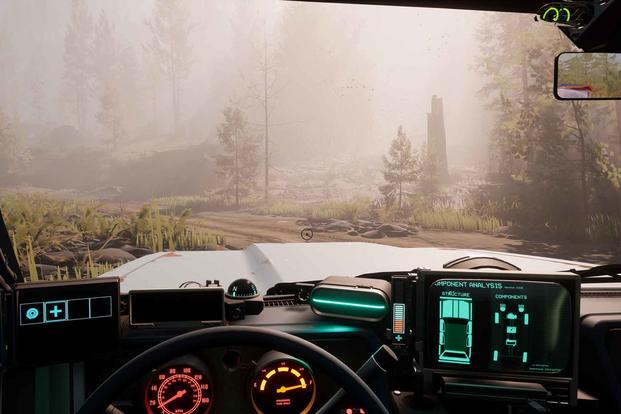SEATTLE — Driving can be a study of contrasts. Mostly it’s mundane: Point A to Point B, with maybe only minor irritation at your fellow drivers. Other times, though, it can be sublime: A beautiful Pacific Northwest day on a traffic-free stretch of scenic byway, the windows down and the wind whipping through your hair as you sing along to the blaring radio. (Or maybe calmly listen to your favorite podcast; to each their own.)
Pacific Drive — out on PlayStation 5 and PC and the first video game developed by Seattle-based Ironwood Studios — is something else entirely.
You’re still in the Pacific Northwest but that’s where the similarities end. You’re trapped in the Olympic Exclusion Zone, and your goal is twofold: to upgrade a retro station wagon and then use said vehicle to explore the mysteries of the zone, dodge supernatural dangers and, eventually, escape. (The main gameplay loop of the survival game is to search the zone for better materials, return to base to upgrade the vehicle and base with those materials, and then rinse and repeat — all while avoiding otherworldly obstacles.) Needless to say, this isn’t your typical morning commute.
We talked with Alex Dracott, founder of Ironwood Studios and director of Pacific Drive, about the game’s Pacific Northwest inspiration, the evolution of the studio from a one-person show to being on the verge of its first game release, and why a station wagon may just become your new best friend.
This interview has been edited for length and clarity.
From a one-person studio to releasing your first game (and the ensuing hype around it) five years later: That’s quite the ride for Ironwood Studios. Tell us about the journey.
It very much started back in 2019. I’d just left Oculus and Facebook a couple months before. And the thing I had in mind and those who kind of started alongside me at that time was, “Hey, we have this idea about a driving survival game. We want to make it happen.” And, you know, the irony of starting a company a month before a global pandemic is not lost on me. It certainly proved to be an initial barrier. It took us a while to figure out the details on how we were actually going to ramp up and make the project happen. And it wasn’t until 2021 that we started growing from just myself and a couple of folks jamming away on this, to close to around 10 people. And since then, we’ve continued to work on the game and grow as a company. So, yeah, it’s definitely quite the ride.
I have to ask about the station wagon.
I drove a family station wagon. I think there’s immediate bias there, right? But when you take a step backwards and you look at the gameplay, a station wagon is mutable. The appeal when they were at their peak is that these cars can do everything: They can pull their family, they can go fast, they can be comfortable, you can strap stuff to the roof. [In the game], we have our quirk mechanic where things can go a little wrong with your car and you have to learn to fix it and pay attention and play detective. We don’t handcraft the combinations. It’s all chosen at the whim of the game. And I think the different combinations help make your car your car. It’s going to have the personality that you’ve given it with your story.
Between Alan Wake II and now Pacific Drive, it would seem the Pacific Northwest is becoming the go-to for horror settings as of late. What inspired you to set Pacific Drive amid the winding roads and looming trees of the PNW?
I grew up in Portland. I spent a year in San Diego and then I pretty much have been in the Greater Seattle area for the past 10, 12 years. When I moved up here, I started taking photography of sightseeing trips out to local abandoned sites in the woods. I would go out and I would find old abandoned ruins and just take cool photos and enjoy the mood. And it was while I was doing these kinds of things that I started thinking there is something unique to the feeling of being on the road that is evocative. It is very much a tone and a mood that I was a fan of. There is a vibe here, right? There is a feeling to the very, very old parts of nature, and that was something that I really did want to capture. But I’ll say this: We did not set out to make a scary game. We certainly set out to make an intense game and have those moments of pressure. After we saw how the game was getting perceived and how we were capturing a tone that was unique, but was also very unsettling, we wanted to lean into it a little bit.
What’s next on the road map for Pacific Drive and Ironwood?
I think the ideals of the studio are very much captured in Pacific Drive. We really love atmospheric and narrative-rich worlds, but we also really love mechanics that help players tell their own stories. With Pacific Drive, it was the Olympic Exclusion Zone and this car that wasn’t just a narrative beat, it was this whole relationship that you were literally reinforcing with the mechanics. And that kind of pairing of mystique and world with player-driven storytelling and character mechanics, we care a lot about that. And I think that’s going to be true no matter what we work on.
———
Pacific Drive
On PlayStation 5 and PC (via Steam and Epic Games Store); rated T for Teen for fantasy violence and language; $29.99 (currently only available digitally; a physical version for PS5 is slated to be released April 9 for $39.99)
———
©2024 The Seattle Times. Visit seattletimes.com. Distributed by Tribune Content Agency, LLC.










